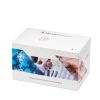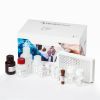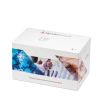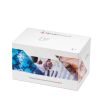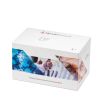FHR-5, Human, ELISA kit – 2 x 96 det. - HK3007-02
Catalog #
HK3007-02
1.359,00 €
Complement Factor H-related protein 5 (FHR-5) is a vital glycoprotein in the complement regulatory protein family. Predominantly synthesized in the liver, FHR-5, Human, also sees production from monocytes, macrophages, and dendritic cells. Weighing approximately 65 kDa, it structurally resembles Complement Factor H (CFH), a crucial regulator in the complement system. FHR-5's primary role lies within the alternative pathway (AP) of the complement system.
FHR-5's functionality extends to binding with various host ligands, including C3b, heparin, C-reactive protein (CRP), Pentraxin 3 (PTX3), and elements of the extracellular matrix. It actively promotes alternative pathway activation on cell surfaces, offering a scaffold for AP C3 convertase assembly. Moreover, FHR-5 may challenge Factor H (FH) by competing for ligand binding, potentially influencing FH's regulatory activities.
Disease associations of FHR-5 are significant yet complex. Genetic variations in the CFHR5 gene have been identified in patients with atypical hemolytic uremic syndrome (aHUS) and age-related macular degeneration (AMD). Furthermore, its presence in both circulating and glomerular forms is linked to IgA nephropathy (IgAN) and familial C3 glomerulopathy (C3G). However, the specific role of FHR-5 in these conditions remains under debate, and other genetic factors may also contribute, underscoring the necessity for further research in this area.
FHR-5, Human, can be measured with our HK3007 assay, designed to precisely quantify this intriguing glycoprotein.
FHR-5's functionality extends to binding with various host ligands, including C3b, heparin, C-reactive protein (CRP), Pentraxin 3 (PTX3), and elements of the extracellular matrix. It actively promotes alternative pathway activation on cell surfaces, offering a scaffold for AP C3 convertase assembly. Moreover, FHR-5 may challenge Factor H (FH) by competing for ligand binding, potentially influencing FH's regulatory activities.
Disease associations of FHR-5 are significant yet complex. Genetic variations in the CFHR5 gene have been identified in patients with atypical hemolytic uremic syndrome (aHUS) and age-related macular degeneration (AMD). Furthermore, its presence in both circulating and glomerular forms is linked to IgA nephropathy (IgAN) and familial C3 glomerulopathy (C3G). However, the specific role of FHR-5 in these conditions remains under debate, and other genetic factors may also contribute, underscoring the necessity for further research in this area.
FHR-5, Human, can be measured with our HK3007 assay, designed to precisely quantify this intriguing glycoprotein.
| Datasheet URL | https://www.hycultbiotech.com/wp-content/uploads/2024/03/HK3007-0224.pdf |
|---|---|
| Quantity | 2x96det. |
| Working volume | 100 µl/well |
| Species | human |
| Cross reactivity | Monkey - No, Mouse - No, Pig - No, Rat - No |
| Alias | Complement Factor H-related protein 5 |
| Principle | The human FHR-5 ELISA is a ready-to-use solid-phase enzyme-linked immunosorbent assay based on the sandwich principle with a working time of 1 hour and 15 minutes. The efficient format of a plate with twelve disposable 8-well strips allows free choice of batch size for the assay. Samples and standards are incubated in microtiter wells coated with antibodies recognizing human FHR-5. Peroxidase-conjugated antibody will bind to the captured FHR-5. Peroxidase-conjugate will react with the substrate, tetramethylbenzidine (TMB). The enzyme reaction is stopped by the addition of oxalic acid. The absorbance at 450 nm is measured with a spectrophotometer. A standard curve is obtained by plotting the absorbance (linear) versus the corresponding concentrations of the human FHR-5 standards (log). The human FHR-5 concentration of samples, which are run concurrently with the standards, can be determined from the standard curve. |
| Storage and stability | Product should be stored at 4 °C. Under recommended storage conditions, product is stable for at least six months. |
| Precautions | For research use only. Not for use in or on humans or animals or for diagnostics. It is the responsibility of the user to comply with all local/state and federal rules in the use of this product. Hycult Biotech is not responsible for any patent infringements that might result from the use or derivation of this product. |
| Disease | Autoimmunity, Infectious diseases, Nephrology, Tumor immunology |
| Principle: | The human FHR-5 ELISA is a ready-to-use solid-phase enzyme-linked immunosorbent assay based on the sandwich principle with a working time of 1 hour and 15 minutes. The efficient format of a plate with twelve disposable 8-well strips allows free choice of batch size for the assay. Samples and standards are incubated in microtiter wells coated with antibodies recognizing human FHR-5. Peroxidase-conjugated antibody will bind to the captured FHR-5. Peroxidase-conjugate will react with the substrate, tetramethylbenzidine (TMB). The enzyme reaction is stopped by the addition of oxalic acid. The absorbance at 450 nm is measured with a spectrophotometer. A standard curve is obtained by plotting the absorbance (linear) versus the corresponding concentrations of the human FHR-5 standards (log). The human FHR-5 concentration of samples, which are run concurrently with the standards, can be determined from the standard curve. |
|---|



